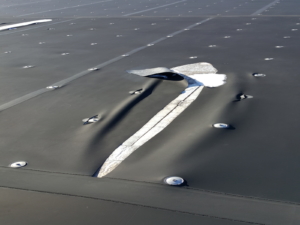 After almost 3 decades of service in the roofing industry, it is quite apparent that our industry has not done a very good job explaining the risks and liabilities of having a dysfunctional roofing system on a business or school building.
After almost 3 decades of service in the roofing industry, it is quite apparent that our industry has not done a very good job explaining the risks and liabilities of having a dysfunctional roofing system on a business or school building.
Facility managers, property managers, and school officials are frustrated by poor performing roofing systems and unskilled contractors. They pay enough for their roofs, but are not getting the performance and longevity out of these systems that they should.
They keep looking for that “miracle in a can or roll”, but can’t seem to find it. More often than not, they choose the low bid because they have difficulty differentiating quality among the bidders and understanding what is or isn’t a qualified bid. They are of the opinion that all roofers can perform the same work equally, so why not take the low bidder? However, choosing an unqualified contractor adds a high degree of risk into your roofing program, including ending up with a roof that frequently leaks.
 The problem with frequent roof leaks is for every $1 of roof repair cost, there is typically a $50 cost associated with consequential damages to the building interior and contents. If these costs were accounted for, most companies would see the total cost of their roofs. There is another area of hidden expense not often talked about, which is the impact of having wet roofing and insulation due to recurring leaks. Wet insulation does not insulate and the wasted energy costs can be staggering. In some cases, clients have gotten 3 year paybacks on roof replacement, just from the energy savings alone!
The problem with frequent roof leaks is for every $1 of roof repair cost, there is typically a $50 cost associated with consequential damages to the building interior and contents. If these costs were accounted for, most companies would see the total cost of their roofs. There is another area of hidden expense not often talked about, which is the impact of having wet roofing and insulation due to recurring leaks. Wet insulation does not insulate and the wasted energy costs can be staggering. In some cases, clients have gotten 3 year paybacks on roof replacement, just from the energy savings alone!
We have a mantra in our company, “If it’s predictable, it’s preventable”. Therefore, performing preventive maintenance, with a pro-active approach, greatly reduces your risks in roofing!
There should be no leak surprises coming from your roofs and walls. Correctly installed systems do not fail overnight, rather it is a progression and can be diagnosed by an expert. You should always have sufficient time to properly repair these deficiencies, unless there is a sudden weather event (tornado, hurricane, etc…) or a fire. Therefore, there is no reason a crisis response should be required. It is clear that performing preventive maintenance on a frequent and timely manner is the lowest cost approach you can implement. Waiting until something breaks is always the most costly and consequential approach to use.
Deferred building maintenance has become popular in facility management, due to budget tightening. However, when a roofing need is deferred, it does not go away, but usually becomes a bigger and more costly problem. Where a simple fix was once possible, you are now forced into a major replacement or roof reconstruction. Failing to act greatly increases your risk in roofing management.
The old expression, “if you can’t afford to do it right the first time, how will you pay the expense of doing it over?” really applies here!
Another factor that raises your risk in managing roofing is inadequate funding and budgeting. One of the major reasons facility managers do not get adequate funding for their roofs is a lack of good information and thorough documentation. Corporate board members, school boards, and property managers like to have the facts, problems, and options for taking corrective action. In addition, they like to see the cost breakdown for the varying options. But in the broadest sense, you always have at least 2 options:
- Do Something
- Do Nothing
In the “Do Something” category, you have multiple options:
- Good, Better, Best
- Low Cost, Mid Cost, High Cost
- Short-term, Mid-Term, Long-Term
Facility managers would benefit from knowing all these options and being able to answer the biggest question of all:
What does it cost if I do it, and what does it cost if I don’t?
However, the problem most facility managers in charge of roofing have… is the lack of information they need. At any given time, facility managers should be able to tell you these crucial pieces of information:
- How many roofs do they have?
- How many square feet of roof per building do they manage, and how much in total?
- How old is each roof?
- What type of roofing system is used on their building(s)?
- What manufacturer provided the roofing system?
- Is the roof system under warranty?
- Who is the installing contractor?
- How much have they spent on roof leaks?
- How much have they spent on preventive maintenance?
- How much have they spent on re-roofing projects?
- What is the condition of each roof?
- What is an accurate budget for maintenance and capital expenditures for this year, next year, etc…?
- How much money have they saved by being proactive with their roof maintenance program?
- How much extra money have they spent by not having a proactive maintenance program?
- What is the average life-expectancy of the roofs they own?
 If these questions cannot easily be answered by a facility manager, it is understandable that they probably don’t get the roofing funding they need. Given that roofing is one of the largest expense items in most building operating budgets (along with HVAC and parking lots), the lack of this basic information is inexcusable and raises the risk you will mismanage your inventory.
If these questions cannot easily be answered by a facility manager, it is understandable that they probably don’t get the roofing funding they need. Given that roofing is one of the largest expense items in most building operating budgets (along with HVAC and parking lots), the lack of this basic information is inexcusable and raises the risk you will mismanage your inventory.
If you are not already seeing the trend, most companies, schools, and property managers are expecting more out of their facilities managers. These organizations want proactive initiatives, not reactive crisis management. The good news is there are professional service companies specializing in roof management to help you in this process.
The best of these companies utilize state-of-the-art software programs to collect and manage client information. Eliminating the huge stack of written reports and paperwork from yesteryear, these firms provide you with on-line access to your roofing data, anytime, and from anywhere you have computer access.
Some of the data and roof information that could be available to you instantly from a professional roof management firm would include:
- A thorough roof condition survey report.
- A Roof CAD drawing of the entire roof area, with individual roof section details.
- Notes of all roof deficiencies marked on the roof plan.
- Descriptive photographs of all roof deficiencies.
- A Roof Condition Index Rating for each roof section, indicating best to worst.
- A color coded Roof CAD drawing with each roof section, showing its’ Roof Condition Index Rating
- A summary of roof section square footages and total roof area.
- A detailed repair or replacement budget report for any repair work identified.
- Every leak area identified on your roof plan with an X mark. You should be able to cursor over these marks and see a before and after picture of the problem and the repair.
- A running total of all your leak and repair costs for the year, on each roof section and for each facility. This will help you better understand where your money is being spent.
- Ability to have a scope of work summary or a comprehensive Roof Design Package for any major work or re-roofing projects you may have.
- Ability to provide you with complete project management services for any major projects you may have, including conducting pre-bid meetings, pre-construction meetings, safety meetings, weekly progress meetings, daily Q.A. inspections, process any change orders, pay requests, and final inspection.
- The capability to perform infra-red moisture inspections, if needed, to determine sources of roof leaks and contaminated roof insulation.
- The ability to access all this information through a website portal. All this information is available to view 24/7 online, anywhere you have computer access. Any of your colleagues or management team can also look at this whenever needed.
A SUMMARY of BENEFITS of Having a Roof Management Program:
No more stacks of reports on your desk.
No more variations of how the information is reported (if it is reported currently).
No more variations on how your roofs are evaluated, ranked by condition, and budgeted.
No more having to extrapolate information from your written reports into management summary reports, used for tracking expenditures and budgets.
Significant reduction of risk in your roofing program, due to proper management, accurate budgets, and preventive maintenance.
A quality roof management program is a genuine time and money saver for yourself and your company, while giving you the power of information to make good decisions. If you are interested in learning more about setting up a roof management program to mitigate your risk, call Moisture Management at 317-577-0910 or email jbush@moisturemanagementllc.com.







